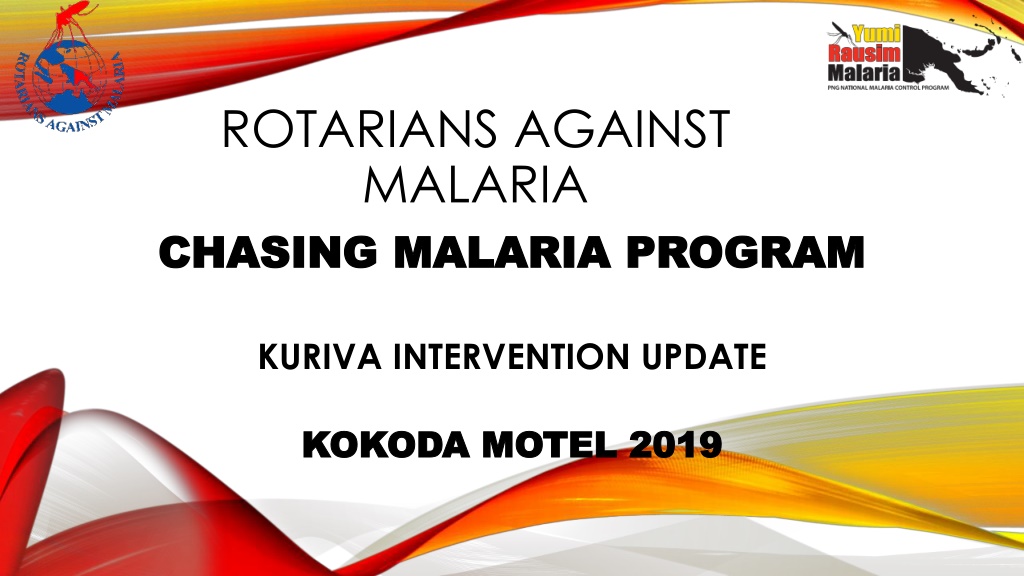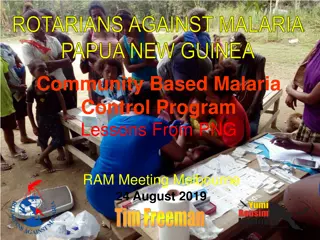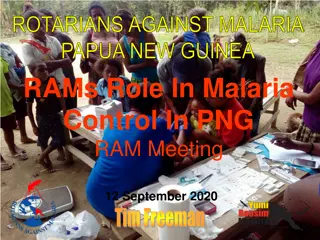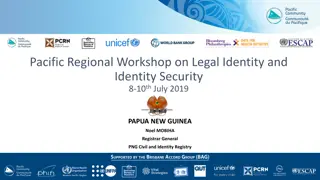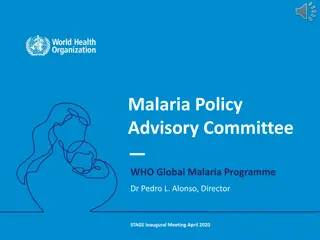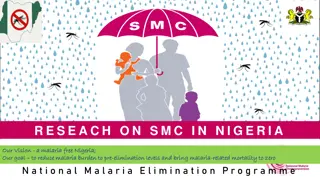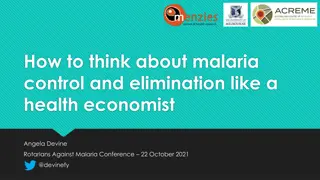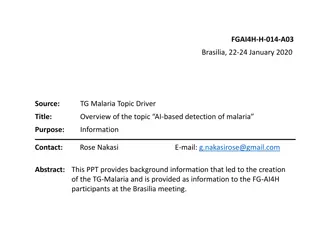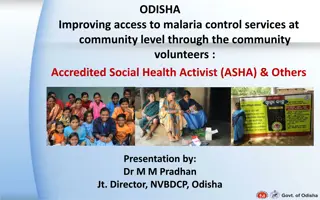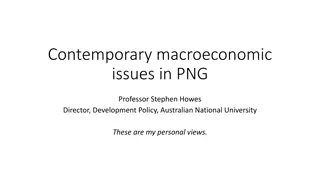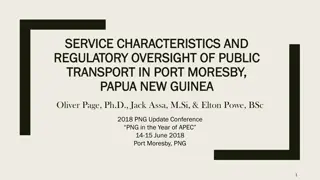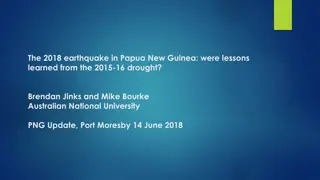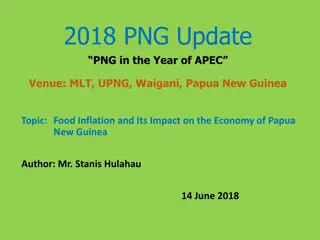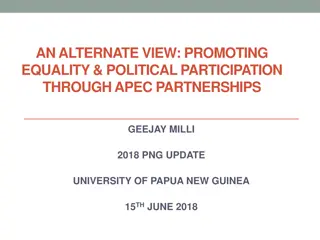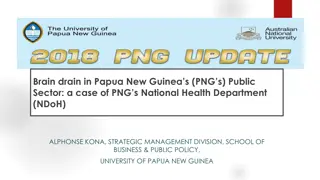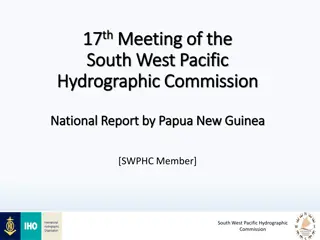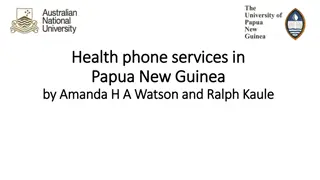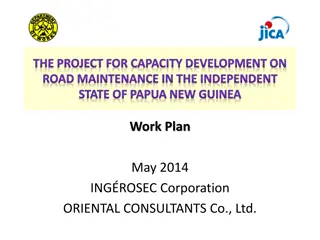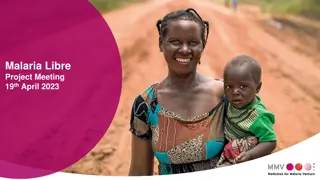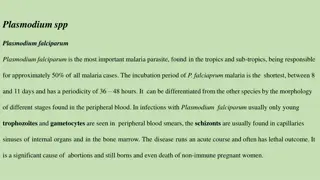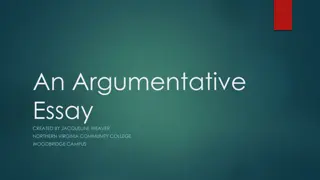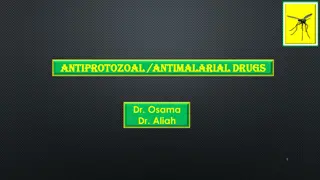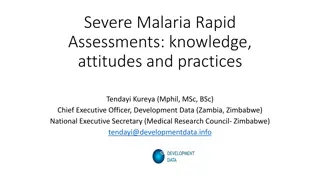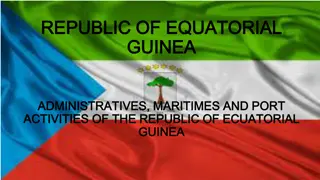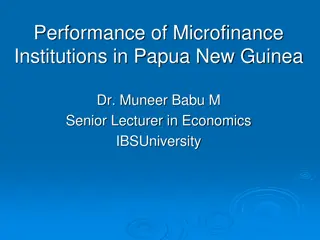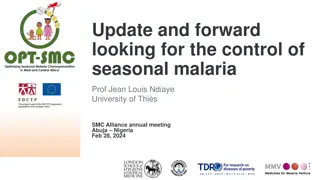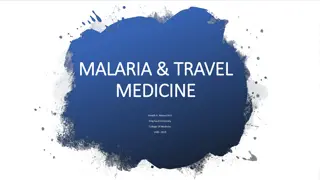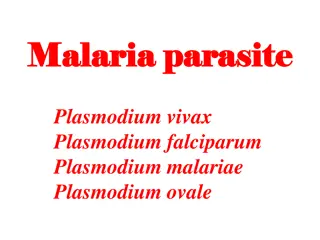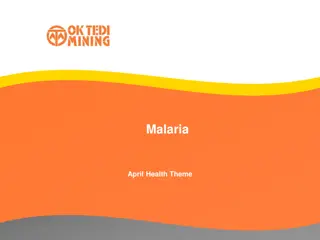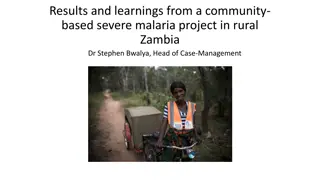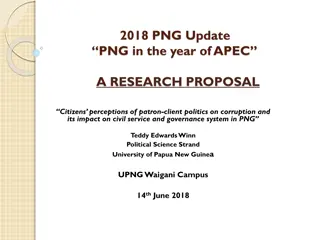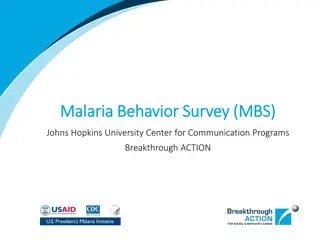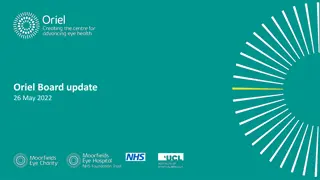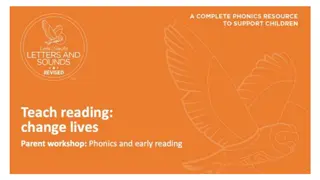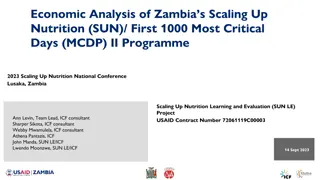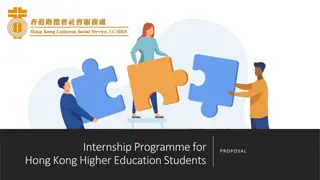Chasing Malaria Programme Updates & Interventions in Papua New Guinea
The Chasing Malaria Programme, funded by Rotarians Against Malaria, focuses on mapping and addressing malaria in Central and NCD Provinces in Papua New Guinea. It involves distributing Long Lasting Insecticidal Nets (LLINs) to areas with malaria cases and collaborating with local communities to combat mosquito breeding sites. The initiative has been successful in providing nets to positive malaria cases, encouraging testing and treatment while collecting valuable data.
Download Presentation

Please find below an Image/Link to download the presentation.
The content on the website is provided AS IS for your information and personal use only. It may not be sold, licensed, or shared on other websites without obtaining consent from the author. Download presentation by click this link. If you encounter any issues during the download, it is possible that the publisher has removed the file from their server.
E N D
Presentation Transcript
ROTARIANS AGAINST MALARIA CHASING MALARIA PROGRAM CHASING MALARIA PROGRAM KURIVA INTERVENTION UPDATE KOKODA MOTEL 2019 KOKODA MOTEL 2019
INTRODUCTION Chasing Malaria Programme is a joint venture between Rotarians Against Malaria and the Provincial Health Authorities presently based in the National Capital District (NCD) and Central Province. This programme in funded by Rotarians Against Malaria alone.
BACKGROUND Chasing Malaria Programme s primary aim is to map malaria within Central and NCD Provinces while at the same time supplying Long Lasting Insecticidal Nets (LLINs) to fill gaps where malaria is a problem: It provides a LLIN to every RDT positive malaria case.
HISTORY OF CHASING MALARIA PROGRAMME. Programme commenced in late Sept 2014 after having successful negotiations with the Central and NCD PHAs earlier same year. LLINs distribution commenced in NCD and central in early and late Oct, 2014 respectively Full coverage achieved in late Nov 2014.
HISTORY CONTD LLINs distribution data collected since early Oct 2014 but full malaria data for all the clinics had been recorded since the beginning of Dec 2014.
THREEFOLD BENEFIT Giving a free net away to positive cases encourages people to seek testing and treatment. Firstly By giving a person a LLIN the net is probably replacing a worn out net in a village where malaria is endemic. Secondly Free LLINs allow health centres to record details of the patient including their movements in the previous three weeks and this information can be mapped. Thirdly
KURIVA INTERVENTIONS This presentation is centred on Chasing Malaria activities which were executed since Apr-Dec 2018 in Kairuku Hiri District, Central Province.
KURIVA INTERVENTION Chasing Malaria Program in Kuriva and Waima catchment areas was initially established to work with the local communities and selected schools to identify mosquito breeding sites, to map those sites and apply community based ideas to destroy those breeding sites.
PARTICIPATING SCHOOLS KAIRUKU RURAL Bereina Primary School Waima UC Primary School St Micheal Primary School Kivori Kui Primary School Kuriva Primary School HIRI RURAL Brown River Primary school. Vanapa Primary school. Kerea Primary School
POSITIVE ACHIEVEMENTS IN KURIVA Therapeutic Efficacy Study (TES) by NDoH and WHO Antimalarial Drug Efficacy is assessed through TES. TES are prospective evaluations of Patients Clinical and Parasitological responses to directly observed treatment for uncomplicated malaria. Studies at regular intervals at the same sites allow for the early detection of resistance Insecticide Resistance Monitoring Study by IMR Anopheles Breeding Sites Laver Collection 12 & 24 Hrs Human Landing Catch (HLC) LLIN Insecticide Efficacy Study Kuriva 12H Barrier Screens Questionnaires Rotarians Against Malaria (RAM) BCC or Behaviour Change Communication. School Malaria Prevalence Survey. School Education on Malaria Topics. School Malaria Clubs. School Health Teacher. Social Mapping in Kuriva & Waima.
POSITIVE ACHIEVEMENTS Mapping work with the local communities in Waima and Kuriva catchment areas and selected schools around Kairuku Hiri district to identify Mosquito breeding sites Map these Sites and Use community based techniques to destroy these breeding sites. School Prevalence Survey Two (2) surveys were carried out in 2018 School Education School Health Teacher School Clubs
POSITIVE ACHIEVEMENTS School Prevalence Survey Two (2) surveys were carried out in 2018 Grand Total Total Positive Prevalan ce % Neg Pf Non-Pf Mix Good sheppard Elementary School (Bereina) 33 1 34 1 2.9 Hereparu Elementary School (Kivori Kui) 32 1 2 35 3 8.6 Kerea Elementary School 15 6 8 2 31 16 51.6 Kivori Early Childhood Learning Centre 164 5 8 1 178 14 7.9 St Michael's Elementary Centre 80 80 0 0.0 Waima United Church Elementary School 57 1 58 1 1.7 Grand Total 381 13 19 3 416 35 8.4
SCHOOL OBJECTIVES Malaria education activities in schools aimed to enrich the school education curriculum package through the following specific objectives: To provide teachers with the necessary skills to conduct malaria education activities for pupils in the classrooms To reach primary school children with interactive sessions to acquire basic knowledge on malaria transmission, signs and symptoms, malaria prevention methods and the importance of timely care seeking. it is expected that pupils will in turn share newly acquired basic knowledge with their parents, families, friends, neighbours and the communities.
KEY QUESTIONS TO ANSWER What is the life cycle of the mosquito? What are the environments in which mosquitoes breed and live? What are some of the different species of mosquitoes and the diseases they are vectors for. What are the current Malaria Control Strategies being used in PNG? What are current methods of Larval Source Management? How can the scientific method be used to explore options for effective larval control?
ACTIVITIES CONDUCTED IN SCHOOLS Flooding streams by building dams and then breaking them every week to flush the mosquitoes away. Filling in the breeding site with soil. Draining of stagnant water where possible. Covering water sources so that mosquitoes cannot reach those (good for water pots for drinking water). Seal water tanks and septic tanks so mosquitoes cannot get in or out. Remove weeds if they prevent fish reaching the larvae.
POSSIBLE PROBLEMS Possible Reasons For Increases In Malaria Shortage of antimalarial commodities People not going for treatment due to lack of access Human Behaviour e.g. Not sleeping under nets, not repairing old nets Mosquitoes biting earlier People staying up late e.g. Watch Movies, Telling stories LLINs no longer working Not treated properly Nets not being repaired
Possible Interventions Mapping of areas to show villages in relationship to health centres and schools Looking for other partners or organisations working in the area Identify any Aid Post and to see their operational status Identify any church or other local action groups Introduce school health master or teacher and if possible village volunteers Ensure health centre dose not run out of malaria commodities Health education in school and village Mosbar and other repellent
2019 WAY FORWARD SCHOOL MALARIA CLUBS SCHOOL MALARIA CLUBS FORMULATION of MALARIA CLUBS - Create Malaria Clubs in the schools. Health teacher should be able to write up activity plans for each week/Months/terms. TECHNICAL SUPPORT - RAM/NDoH/ will provide technical advice and support to the club. School clubs can be able to do school excursion with their health teacher to other schools to learn new ideas from other schools. School Club debates on Malaria topics at end of each term. PLANNING - Meet with Designated School Principals and health teachers to Collect 2019 statistics for Elementary and Primary Schools pupils. TRAINNING - Re-establish the concept and the importance of the malaria Club with the school Principals and Teachers.
WAY FORWARD OBJECTIVES /Aim earning Basic Basic Malaria Malaria Topic All Teachers from the selected schools to create basic malaria lessons or topics for the school Childers to know the significance of malaria parasites and mosquito lifecycle including (all grades from elementary to grade 8). OBJECTIVES /Aim L Learning Topic. . 1. Constructed Constructed Mosquito To Keep Mosquito demonstration from different instars. Mosquito House Larvae House. in 1. the containers for student 1. Identify different mosquito species such as culux, Aedes and anopholine mosquitos from Larvae stage to puper stage and adult stage. Introduce Introduce HMM School Health Teachers from the selected schools can be trained on how to conduct RDT testing and also give treatments. HMM program program in in selected selected School School. . 1. 1. Lean about mosquito behaviour for example; (Biting time, Biting Location and Biting seasons) 2. Participating school health teachers should know the importance of three 3 Ts stands for Test, Treat and Track. No Mosquitos in School for healthy leaning Check on mosquitos breading sites in and around the School perimeter and destroy once every week. 1. Using Using Barrier Barrier Screens Using old mosquito nets as Barriers screens to study mosquito movements from school side and bush side. Screens. . 1. 2. Keep classrooms clean and neat for learning to avoid getting sick and missing lessons/teaching. This information is very important to help provide the Best possible mosquito control in the selected schools. 3. Collecting Larvae and destroy the sites within school ground once every week.
WAY FORWARD Identify Strong Community Leadership Member within all villages that can be able to lead the community. Form Group - Identify clubs or groups such as Church Club Woman Ministry Group, Sporting Club and etc. Meeting Leaders - Identify ward counsellors, Community Leaders and youth leaders to introduce the concept and the importance of establishing the malaria club within the villages, Wards or LLGs and around the communities. Community Awareness Community Awareness On Malaria related health issues. Prevalence Survey - Conduct Household prevalence survey in high burden areas within Kuriva HC Catchments before rolling out the program to other sites. Leader - Implementation of Project - To implement the project, Pilot the program in 1 or 2 villages or wards and later roll out the Program. Recruitment Of Nurse - Identify a retired Nursing Officer with a valid practicing certificate who can give treatments in communities. (Distance places example; Vaikabu and Brown River catchments.) Mosbar - Distribute Mosbar to village people for evening use such as; telling stories with friends, woman cooking, man going hunting, kids watching moves, evening devotion and etc. - Prepare
WAY FORWARD CLUB INCENTIVES Financial support is not necessary to the clubs as we are not paying for the service. But again when we look at the reverse side of the coin, Clubs need money to work as a community, example like Organisation Needs money to implement projects or work in the communities. Financial Assistance - 300 Kina should be given by the program to each clubs as incentive package support the club within the Wards. CLUB INCENTIVES Tools - Money given to the club s is purposely to buy tools such as; knife, spade, fork and etc. House Marasin - Due to distance to the health centre, clubs can all work together to build a MALARIA HOUSE MARASIN Really the Retired Nurse should only conduct TEST, TREAT and TRACK to the neighbouring communities. Mosbar - Ram can supply Mosba s to each clubs for selling. However, money collected can be used to support the clubs. Donations Of Tools Chasing Malaria Program to donate working tools for the clubs to maintain the full ownership of the program within the community.
THANK YOU VERY MUCH EM TASOL !!
